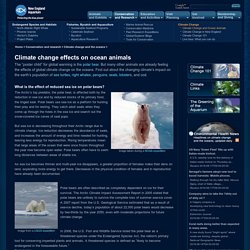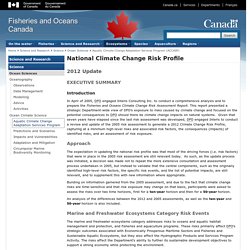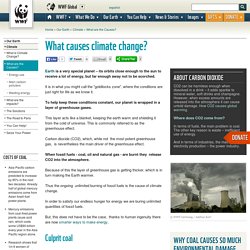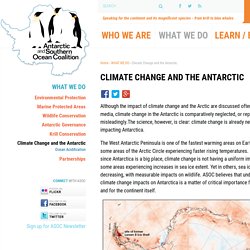

Here's Who To Blame For America's Increased Contribution To Global Warming In 2013. By Emily Atkin Posted on Share this: "Here’s Who To Blame For America’s Increased Contribution To Global Warming In 2013" Share: CREDIT: Shutterstock A new report released by the Environmental Protection Agency on Thursday shows just how much large American industrial facilities including power plants, refineries, and chemical manufacturers contributed to global warming in 2013.

Emissions of greenhouse gases from large industrial sources increased by 0.6 percent since 2012, according to the EPA’s Greenhouse Gas Reporting Program data, which is compiled from reports sent in by more than 8,000 emitters. Wonderful Antarctica. Why You Should Care About The Antarctic Climent Change The state of the global climate is shifting drastically out of proportion with the natural balance of the earth.

The Antarctic ice cap is melting and losing mass at a drastic rate. This means that we will see more drastic weather changes and more species of living organisms going extinct. 6 Industries That Will Profit From Global Warming. The_ocean_and_climate_change.pdf. Climate Change Impacts & Threats. Climate change: the effects on ocean animals. The “poster child” for global warming is the polar bear.

But many other animals are already feeling the effects of global climate change on the oceans. Find out about the changing climate's impact on the earth’s population of sea turtles, right whales, penguins, seals, lobsters, and cod. The Arctic’s top predator, the polar bear, is affected both by the reduction in sea ice and by reduced stocks of its primary food, the ringed seal. Polar bears use sea ice as a platform for hunting their prey and for resting. Aquatic Climate Change Adaptation Services Program (ACCASP) In general, precipitation is expected to increase in high latitudes and in locations and seasons that presently have high precipitation, and to decrease in locations elsewhere and seasons that presently have low precipitation.

A decrease in summertime precipitation, coupled with increased evapotranspiration, can lead to a reduction in inland freshwater levels at mid latitudes. Table 2 lists the impacts associated with changes in precipitation, cloud cover, humidity and wind patterns. Table 2: List of Impacts Due to Changes in Precipitation Increasing Frequency of Severe Weather Events and Changes to Storm Tracks Warmer temperatures could create conditions for more severe weather events. Table 3 lists the impacts associated with increasing frequency of severe weather events. Table 3: List of Impacts Due to Severe Weather. Sea Level Rise. Manipulating climate to fight global warming. Top 10 ways you can stop climate change. (Derivative of Photo by Natesh Ramasamy via Flickr used under CC BY).

Ever wonder how your tiny carbon footprint really impacts the big picture of climate change? Though you might feel like your lifestyle is insignificant compared to things like oil extraction or vehicle emissions, the choices we make in our day-to-day life — how we get around, what we eat, how we live — play a major role in slowing climate change.
Here's a list of 10 ways you can join in the fight to reduce our carbon footprint. Whether you save it on your desktop, share it with friends, or stick a copy on your fridge (PDF), this quick reference guide breaks down what you can do today to protect the planet for future generations. 1. Take a few minutes to contact your political representatives and the media to tell them you want immediate action on climate change. 2. You already switch off lights — what's next? 3. Ask your utility to switch your account to clean, renewable power, such as from wind farms. 4. 5. 6. 7. 8. What causes climate change? The biggest climate polluter is the global power sector which generates around 40% of all global electricity from coal.

We need electricity - but when you take into account the true cost of coal there are much better ways to get it! According to the International Energy Agency the power sector is responsible for 37% of all man-made Carbon Dioxide (CO2) emissions. It creates about 23 billion tonnes of CO2 emissions per year – in excess of 700 tonnes a second. In turn, this CO2 continues to heat up our planet which poses an unprecedented threat to us and the environment. Generating electricity through the burning of fossil fuels, in particular carbon-heavy coal, has a greater impact on the atmosphere than any other single human activity.
Coal is the world's most widely available fossil fuel Weaning humanity off coal will not be easy. But coal is not cheap - if you have to pay for it all Too many governments still subsidize coal production which distorts the energy market. How climate change is affecting the Reef. Climate Change. Global Warming. The_ocean_and_climate_change.pdf. Effects. Global climate change has already had observable effects on the environment.

Glaciers have shrunk, ice on rivers and lakes is breaking up earlier, plant and animal ranges have shifted and trees are flowering sooner. Effects that scientists had predicted in the past would result from global climate change are now occurring: loss of sea ice, accelerated sea level rise and longer, more intense heat waves. Taken as a whole, the range of published evidence indicates that the net damage costs of climate change are likely to be significant and to increase over time. Scientists have high confidence that global temperatures will continue to rise for decades to come, largely due to greenhouse gases produced by human activities.
The Intergovernmental Panel on Climate Change (IPCC), which includes more than 1,300 scientists from the United States and other countries, forecasts a temperature rise of 2.5 to 10 degrees Fahrenheit over the next century. Future effects Temperatures will continue to rise. Climate Change and the Antarctic - Antarctic and Southern Ocean Coalition. Although the impact of climate change and the Arctic are discussed often in the media, climate change in the Antarctic is comparatively neglected, or reported misleadingly.The science, however, is clear: climate change is already negatively impacting Antarctica.

The West Antarctic Peninsula is one of the fastest warming areas on Earth, with only some areas of the Arctic Circle experiencing faster rising temperatures. However, since Antarctica is a big place, climate change is not having a uniform impact, with some areas experiencing increases in sea ice extent. Yet in others, sea ice is decreasing, with measurable impacts on wildlife. Global Warming and Climate Change. Avoiding the worst impacts of climate change requires a fundamental shift in the way we consume and generate energy.

This shift should begin immediately and be well underway within the next ten years. The scale of the challenge requires a complete transformation of the way we produce, consume and distribute energy. Fortunately, we can meet this challenge while giving a boost to the economy, energy sector employment and energy security. Global Warming: Overview and Causes. Global Warming, the general increase in the earth's near-surface air and ocean temperatures, remains a pressing issue in a society that has expanded its industrial use since the mid-twentieth century.

Greenhouse gases, atmospheric gases that exist to keep our planet warm and prevent warmer air from leaving our planet, are enhanced by industrial processes. As human activity such as the burning of fossil fuels and deforestation increases, greenhouse gases such as Carbon Dioxide are released into the air. Normally, when heat enters the atmosphere, it is through short-wave radiation; a type of radiation that passes smoothly through our atmosphere. As this radiation heats the earth's surface, it escapes the earth in the form of long-wave radiation; a type of radiation that is much more difficult to pass through the atmosphere.
Greenhouse gases released into the atmosphere cause this long-wave radiation to increase. Causes of Global Warming Deforestation. Sea Temperature Rise. As climate change has warmed the Earth, oceans have responded more slowly than land environments. But scientific research is finding that marine ecosystems can be far more sensitive to even the most modest temperature change. Global warming caused by human activities that emit heat-trapping carbon dioxide has raised the average global temperature by about 1°F (0.6°C) over the past century. In the oceans, this change has only been about 0.18°F (0.1°C). This warming has occurred from the surface to a depth of about 2,300 feet (700 meters), where most marine life thrives. Causes of Climate Change. Key Points Both natural and human factors change Earth’s climate. Before humans, changes in climate resulted entirely from natural causes such as changes in Earth’s orbit, changes in solar activity, or volcanic eruptions.
Since the Industrial Era began, humans have had an increasing effect on climate, particularly by adding billions of tons of heat-trapping greenhouse gases to the atmosphere. Climate change: the effects on ocean animals. International Mountain Museum, Ghari Patan, Pokhara. Here's Who To Blame For America's Increased Contribution To Global Warming In 2013. Climate change. Climate is the long-term pattern of weather in a particular area. Weather can change from hour to hour, day to day, month to month or even from year to year. For periods of 30 years or more, however, distinct weather patterns occur. A desert might experience a rainy week, but over the long term, the region receives very little rainfall. It has a dry climate. Because climates are mostly constant, living things can adapt to them. Climates do change, however—they just change very slowly, over hundreds or even thousands of years.
How does the Greenhouse Effect happen. How does the Greenhouse Effect happen? Causes. Most climate scientists agree the main cause of the current global warming trend is human expansion of the "greenhouse effect"1 — warming that results when the atmosphere traps heat radiating from Earth toward space. Certain gases in the atmosphere block heat from escaping. Long-lived gases that remain semi-permanently in the atmosphere and do not respond physically or chemically to changes in temperature are described as "forcing" climate change. Gases, such as water vapor, which respond physically or chemically to changes in temperature are seen as "feedbacks. "